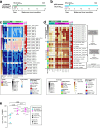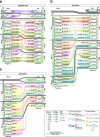High expression of Rex-orf-I and HBZ mRNAs and bronchiectasis in lung of HTLV-1A/C infected macaques
- PMID: 41006234
- PMCID: PMC12474910
- DOI: 10.1038/s41467-025-63325-1
High expression of Rex-orf-I and HBZ mRNAs and bronchiectasis in lung of HTLV-1A/C infected macaques
Abstract
HTLV-1 type-A rarely causes lung disease in humans, whereas HTLV-1 type-C is more frequently associated with respiratory failure and premature death. We investigated the genetic basis of HTLV-1C morbidity by constructing a chimeric HTLV-1A/CoI-L encompassing the highly divergent type C orf-I. We demonstrate that systemic infectivity of HTLV-1A and HTLV-1A/CoI-L is equivalent in macaques, but viral expression in lungs is significantly higher in HTLV-1A/CoI-L infection. In addition, bronchoalveolar-lavage immune cell dynamics differs greatly with neutrophils and monocytes producing TNF-α in HTLV-1A/CoI-L, but producing IL-10 in HTLV-1A infection. Animals infected with HTLV-1A/CoI-L develops bronchiectasis at 10 months from infection, but at the same timepoint those infected with HTLV-1A do not. HTLV-1A/CoI-L expressed a 16 kDa fusion protein (p16C) via a doubly spliced, Rex-orf-IC, mRNA able to shield T-cells from efferocytosis, a monocyte function that mitigates inflammation via clearance of apoptotic cells. The Rex-orf-IC mRNA is expressed as more frequent in the lung of HTLV-1A/CoI-L than HTLV-1A infected animals. Since defective efferocytosis is associated with lung obstructive pathologies, the data raise the hypothesis that p16C may contribute to the lung morbidity observed in HTLV-1C infection.
© 2025. This is a U.S. Government work and not under copyright protection in the US; foreign copyright protection may apply.
Conflict of interest statement
Competing interests: The authors declare no competing interests.
Figures






References
-
- Kaplan, J. E. et al. The risk of development of HTLV-I-associated myelopathy/tropical spastic paraparesis among persons infected with HTLV-I. J. Acquir Immune Defic. Syndr.3, 1096–1101 (1990). - PubMed
-
- Martin, F., Taylor, G. P. & Jacobson, S. Inflammatory manifestations of HTLV-1 and their therapeutic options. Expert Rev. Clin. Immunol.10, 1531–1546 (2014). - PubMed
-
- Bangham, C. R., Araujo, A., Yamano, Y. & Taylor, G. P. HTLV-1-associated myelopathy/tropical spastic paraparesis. Nat. Rev. Dis. Prim.1, 15012 (2015). - PubMed
-
- Matsuura, E. et al. HTLV-1 associated myelopathy/tropical spastic paraparesis (HAM/TSP): A comparative study to identify factors that influence disease progression. J. Neurol. Sci.371, 112–116 (2016). - PubMed
MeSH terms
Substances
LinkOut - more resources
Full Text Sources
Miscellaneous

